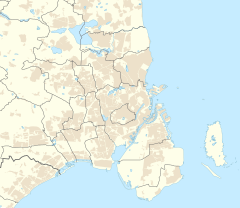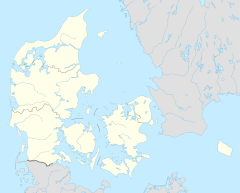Birkerød railway station
| S-train station | |||||||||||
 Birkerød station in 2010 | |||||||||||
| General information | |||||||||||
| Location | Stationsvej 5 3460 Birkerød[1] Rudersdal Municipality Denmark | ||||||||||
| Coordinates | 55°50′25″N 12°25′26″E / 55.84028°N 12.42389°E | ||||||||||
| Elevation | 52.2 metres (171 ft)[2] | ||||||||||
| Owned by | Banedanmark and DSB | ||||||||||
| Line(s) | North Line[3] | ||||||||||
| Platforms | 1 side platform 1 island platform | ||||||||||
| Tracks | 3 | ||||||||||
| Train operators | DSB[3] | ||||||||||
| Connections | Bus | ||||||||||
| Construction | |||||||||||
| Architect | Vilhelm Carl Heinrich Wolf[4] | ||||||||||
| Other information | |||||||||||
| Station code | Bi[5] | ||||||||||
| Website | Official website | ||||||||||
| History | |||||||||||
| Opened | 1864[2] | ||||||||||
| Rebuilt | 26 May 1968 (S-train)[6] | ||||||||||
| Electrified | 26 May 1968[6] | ||||||||||
| Services | |||||||||||
| |||||||||||
| |||||||||||
Birkerød station is an S-train railway station serving the satellite town of Birkerød north of Copenhagen, Denmark.[1] The station is located in the centre of the town, a short distance from Birkerød Church and Birkerød Lake.
Birkerød station is located on the Hillerød radial of Copenhagen's S-train network, a hybrid suburban rail and rapid transit system serving Greater Copenhagen.[3] It is served regularly by trains on the A-line which have a journey time to central Copenhagen of around 20 minutes.[1]
The station opened in 1864 with the opening of the North Line between Copenhagen and Helsingør via Hillerød, and has been served by the S-train network since 1968.[2][6] The original station building from 1864 was built to designs by the Danish architect Vilhelm Carl Heinrich Wolf (1833–1893).[4]
History
[edit]
Birkerød station opened on 8 June 1864 as the privately owned Det Sjællandske Jernbaneselskab (the Zealand Railway Company) opened the second section of the North Line which connected Copenhagen with Helsingør via Hillerød.[7] On 1 January 1880, the railway station was taken over by the Danish state along with the Zealand Railway Company.[8] And on 1 October 1885, it became part of the new national railway company, the Danish State Railways.[9]
When built, the railroad station was situated a bit outside the old village of Birkerød. The reason for this was that it had to be situated on a hill to make it easier to get the trains started again after stopping. However, the opening of the station led to economic growth in the area and several brickyards opened in the area in the second half of the 19th century, and construction of new residential neighbourhoods accelerated in the 1940s which, in time, made the old village of Birkerød merge with the villages of Bistrup to the south, Kajerød to the west and Ravnsnæs to the east, so today the station is located in the centre of the town.[10]
The railway line proved a great success, and in the 1930s the originally single-track railway line was expanded to double-track. As part of the doubling, an island platform with an associated platform tunnel and a short platform roof was built at the station.
On 26 May 1968, the station at Birkerød became integrated into the S-train network as the S-train line that serves the North Line was extended from Holte to Hillerød.[6]
Architecture
[edit]Like the other station buildings on the North and Klampenborg Lines, Birkerød station's original and still existing station building from 1864 was built to designs by the Danish architect Vilhelm Carl Heinrich Wolf (1833–1893).[4]
The station infrastructure was modernized in 2016 with a new bicycle parking station allowing direct access to the platforms, new platform roofs, and renovated stairs and underpass.[11][12]
Facilities
[edit]Adjacent to the station is the Birkerød bus station. The station forecourt has a taxi stand, and the station also has a bicycle parking station as well as a car park with approximately 174 parking spaces.[1]
Operations
[edit]Birekrød station is served regularly by trains on the A-line of Copenhagen's S-train network which run between Hillerød and Hundige / Køge via central Copenhagen.[3] Trains have a journey time to central Copenhagen of around 20 minutes and to Hillerød of around 10 minutes.[1]

Cultural references
[edit]In 1984, the local art association arranged for the controversial Danish artist, film director and musician Jens Jørgen Thorsen to decorate an empty concrete wall at the station. He chose to paint the crucified Jesus with an erect penis, which some Christians found blasphemous.[13] After being approached by the Christian People's Party, the then Minister of Transport Arne Melchior ordered the Danish State Railways to have the art work painted over.[14] The affair led to a public debate about both blasphemy and freedom of expression.
Number of travellers
[edit]According to the Østtællingen in 2008:[15]
| År | Antal | År | Antal | År | Antal | År | Antal |
|---|---|---|---|---|---|---|---|
| 1957 | – | 1974 | 3.716 | 1991 | 4.413 | 2001 | 4.316 |
| 1960 | – | 1975 | 3.756 | 1992 | 4.312 | 2002 | 3.993 |
| 1962 | – | 1977 | 3.631 | 1993 | 4.523 | 2003 | 4.497 |
| 1964 | – | 1979 | 4.563 | 1995 | 4.662 | 2004 | 4.480 |
| 1966 | – | 1981 | 5.189 | 1996 | 4.444 | 2005 | 4.001 |
| 1968 | 3.036 | 1984 | 4.731 | 1997 | 4.462 | 2006 | 4.158 |
| 1970 | 3.509 | 1987 | 4.537 | 1998 | 4.446 | 2007 | 4.154 |
| 1972 | 3.818 | 1990 | 4.411 | 2000 | 4.431 | 2008 | 4.402 |
Gallery
[edit]-
Forecourt
-
Stairs
-
Elevator
-
Underpass
-
Platforms
-
Bus connection
See also
[edit]- List of Copenhagen S-train stations
- List of railway stations in Denmark
- Rail transport in Denmark
- Transport in Copenhagen
References
[edit]Citations
[edit]- ^ a b c d e "Birkerød Station". DSB. Retrieved 8 January 2023.
- ^ a b c "Birkerød Station (Bi)". danskejernbaner.dk (in Danish). Retrieved 22 August 2024.
- ^ a b c d "S-tog" (in Danish). DSB. Retrieved April 13, 2024.
- ^ a b c Thomas Kappel. "V.C.H. Wolf". Kunstindeks Danmark & Weilbach Kunstnerleksikon. Retrieved 12 April 2024.
- ^ "Stationsforkortelser" (in Danish). DSB. Retrieved April 12, 2024.
- ^ a b c d "1960–1970 – S-togets historie" (in Danish). DSB. Retrieved 22 August 2024.
- ^ Jensen 1972, p. 20.
- ^ Jensen 1972, p. 74.
- ^ Jensen 1972, p. 88.
- ^ "Birkerød" (in Danish). Rudersdal Kommune. Archived from the original on 20 April 2013. Retrieved 5 December 2015.
- ^ "Birkerød Station får et løft" (in Danish). DSB Ejendomme. 2016.
- ^ "Birkerød station" (in Danish). Gottlieb Paludan Architects. 2018.
- ^ Nielsen, Jacob (31 March 2010). "Erigeret Jesus vender tilbage til Birkerød" [Jesus returned to Birkerød Station]. Lokalavisen (in Danish). Retrieved 22 August 2024.
- ^ Nielsen, Karen (29 March 2010). "Jesus vendte tilbage til Birkerød Station" [Erect Jesus returns to Birkerød]. DR (in Danish). Retrieved 22 August 2024.
- ^ "Østtælling 2008 DSB og DSB S-tog". 2008-11-13. p. 17. Archived from the original on May 18, 2023.
Bibliography
[edit]- Jensen, Niels (1972). Danske Jernbaner 1847–1972 [Danish railways 1847–1972] (in Danish). Copenhagen: J. Fr. Clausens Forlag. ISBN 87-11-01765-1.
- Poulsen, John; Christensen, Jens Ole; Thomassen, Peer; Zeeberg, Nils Kristian (1984). Københavns S-bane 1934-1984 (in Danish). Roskilde: Bane Bøger. ISBN 87-88632-01-6.
- Poulsen, John; Larsen, Morten Flindt (2009). S-banen 1934-2009 (in Danish). Roskilde: Bane Bøger. ISBN 978-87-91434-20-4.
External links
[edit]- Official website

- (in Danish) Banedanmark – government agency responsible for maintenance and traffic control of most of the Danish railway network
- (in Danish) DSB – the Danish national train operating company
- (in Danish) Danske Jernbaner – website with information on railway history in Denmark











